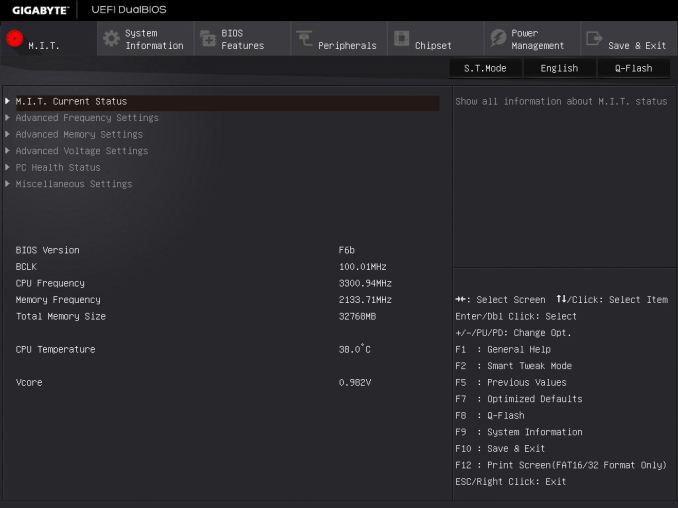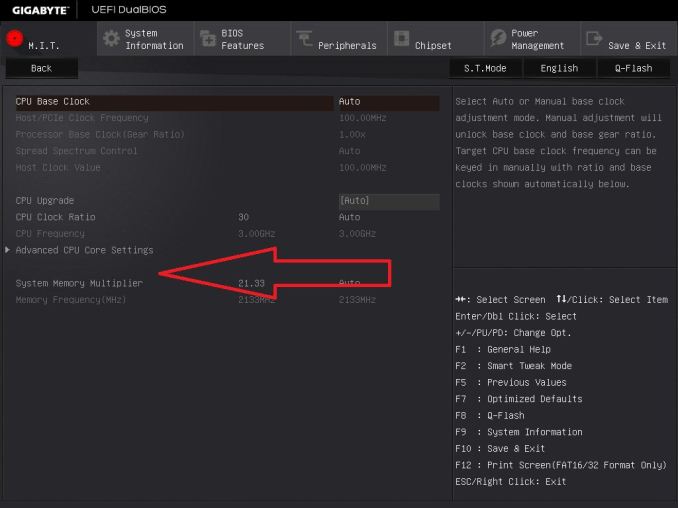DDR4 Haswell-E Scaling Review: 2133 to 3200 with G.Skill, Corsair, ADATA and Crucial
by Ian Cutress on February 5, 2015 10:10 AM ESTEnabling XMP
By default, memory should adhere to specifications set by JEDEC (formerly known as the Joint Electron Device Engineering Council). These specifications state what information should be stored in the memory EEPROM, such as manufacturer information, serial number, and other useful information. Part of this is the memory specifications for standard memory speedswhich a system will adhere to in the event of other information not being available. For DDR4, this means DDR4-2133 15-15-15 at 1.20 volts.
An XMP, or (Intel-developed) Extreme Memory Profile, is an additional set of values stored in the EEPROM which can be detected by SPD in the BIOS. Most DRAM has space for two additional SPD profiles, sometimes referred to as an ‘enthusiast’ and an ‘extreme’ profile; however most consumer oriented modules may only have one XMP profile. The XMP profile is typically the one advertised on the memory kit – if the capability of the memory deviates in any way from specified JEDEC timings, a manufacturer must use an XMP profile.
Thus it is important that the user enables such a profile! It is not plug and play!
As I have stated since reviewing memory, at big computing events and gaming LANs there are plenty of enthusiasts who boast about buying the best hardware for their system. If you ask what memory they are running, then actually probe the system (by using CPU-Z), more often than not the user after buying this expensive memory has not enabled XMP. It sounds like a joke story, but this happened several times at my last iSeries LAN in the UK – people boasting about high performance memory, but because they did not enable it in the BIOS, were still running at DDR3-1333 MHz C9.
So enable XMP with your memory!
Here is how for most motherboards except the ASUS X99-Deluxe, which uses an onboard XMP switch:
Step 1: Enter the BIOS
This is typically done by pressing DEL or F2 during POST/startup. Users who have enabled fast booting under Windows 8 will have to use motherboard vendor software to enable ‘Go2BIOS’ or a similar feature.
Step 2: Enable XMP
Depending on your motherboard manufacturer, this will be different. I have taken images from the major four motherboard manufacturers to show where the setting is on some of the latest X99 motherboard models.
On any ASUS X99 board, the setting is on the EZ-Mode screen. Where it says ‘XMP’ on the left, click on this button and navigate to ‘Profile 1’:
If you do not get an EZ mode (some ROG boards go straight to advanced mode), then the option is under the AI Tweaker tab, in the AI Overclock Tuner option, or you can navigate back to EZ mode.
For ASRock motherboards, depending on which model you have, navigate to OC Tweaker and scroll down to the DRAM Timing Configuration. Adjust the ‘Load XMP Setting’ option to Profile 1.
For GIGABYTE motherboards, press F2 to switch to classic mode and navigate to the MIT tab. From here, select Advanced Frequency Settings.
In this menu will be an option to enable XMP where this arrow is pointing:
Finally on MSI motherboards, we get a button right next to the OC Genie in the BIOS to enable XMP:
I understand that setting XMP may seem trivial to most of AnandTech’s regular readers, however for completeness (and the lack of XMP being enabled at events it seems) I wanted to include this mini-guide. Of course different BIOS versions on different motherboards may have moved the options around a little – either head to enthusiast forums, or if it is a motherboard I have reviewed, I tend to post up all the screenshots of the BIOS I tested with as a guide.















120 Comments
View All Comments
Dasa2 - Thursday, February 5, 2015 - link
To back up some of what i said here is a few linksI3 2100 matching 2500k@4ghz in dirt 3
http://www.tomshardware.com/reviews/gaming-fx-pent...
Arma a cpu bottlnecked game where a 2600k@4.3ghz with 2133c9 ram is faster than at 4.9ghz with 1600c11
http://forums.bistudio.com/showthread.php?166512-A...
Thief CPU|RAM performance
http://forums.atomicmpc.com.au/index.php/topic/557...
Bf4 1600c9=60fps 2400c10=70fps
http://www.team-greatbritain.com/call-of-duty-ghos...
Xbit ddr3 review looks a bit different to yours...
http://www.xbitlabs.com/articles/memory/display/ha...
Margalus - Friday, February 6, 2015 - link
And not one of those is using ddr4...Dasa2 - Friday, February 6, 2015 - link
Nope hence why I would like a decent review site like anandtech to do a proper job of there ddr4 reviewIm not expecting a big of a difference from higher speeds quad channel ddr4 by comparison to what can be seen in dual channel ddr3 but even there haswell ddr3 tests showed jack all due to the same problem with there tests so how can we know for sure
FlushedBubblyJock - Sunday, February 15, 2015 - link
You're correct, you made your points, so of course someone without many watts currently on display there said something silly, as usual being stupid pays off and those not dumbed down to base below average levels suffer the frustrating beyond belief consequences.mrcaffeinex - Friday, February 6, 2015 - link
The problem is that we currently do not have a non-enthusiast platform available that supports DDR4. The new X99 platform is also running quad-channel, so the best comparison to a prior platform would have to be using X79 (attempting to keep as close to apples to apples as possible). The point that can be taken from this article as it is right now, is that you can skip buying insanely-priced DDR4-3000+ memory because your X99 rig will probably not perform noticeably different with DDR4-2133.As the process matures and more systems adopt DDR4, then you'll be able to do a better comparison across multiple performance levels, but as it is right now, if you're buying into X99, you're buying a high-end CPU. I look forward to the extensive comparative tests that you have mentioned, but I do not see them happening until either the mainstream platform (LGA 115x) is running DDR4 or AMD has any offering that supports DDR4.
Dasa2 - Friday, February 6, 2015 - link
Unfortunately you cant take that from this article as the gaming tests wouldnt show if there was any gain from faster ram even if it did boost cpu performance by 15%These tests were worse than a complete waist of time from a gaming perspective as they could be very misleading
At a guess i would expect to see somewhere between 3-7% difference going from ddr4 2133 to ddr4 3200 at the same timings although most of that gain will probably be between 2133 and 2666 happy to be proven wrong though
Sushisamurai - Friday, February 6, 2015 - link
although I agree it would be nice to see the impact DDR4 timings and speeds on CPU bound games, I unfortunately don't see the real world application to it. With DDR4, we're working on Haswell-E, which already has a lot of compute power - if we were to run into any CPU bottlenecks, wouldn't it make more sense to spend more of the budget into the CPU instead of RAM? Unless, you had enough money to buy top CPU and top RAM, then the point becomes quite moot no?Dasa2 - Friday, February 6, 2015 - link
Depends how big the gain is from faster ram doesnt it and we wont know that until its tested properly with the ram speed compared cpu speeds toTesting cpu or ram performance with gpu bottleneck games is a waist of time unless your AMD trying to sell fx8150...
The only cpu limited games at this stage on Haswell-E will be the ones with bad multithreading support so spending a heap more on the cpu for extra cores from the 5960x wont help
What will help is spending extra for a better overclock and maybe faster ram but how far do you go
tim851 - Friday, February 6, 2015 - link
> The games you chose to review are so badly GPU bottlenecked its sad.That's why they were running these games at reduced resolutions and IQ settings, Einstein.
What game should Anandtech benchmark that is NOT GPU LIMITED - Quake 3 Arena?
Dasa2 - Friday, February 6, 2015 - link
They shouldnt reduce detail settings just no aa and resolution to 1080p while running a gtx980 or two (r9-290\gtx970\gtx780oc minimum)But with the likes of dirt 3 even if they do reduce detail settings its still gpu bottlnecked
Arma\Dayz are some of the only games that can be cpu bottlnecked with a single gtx770
Dying Light is very demanding on both cpu and gpu
http://translate.googleusercontent.com/translate_c...
There is a lot of games that can be a bit of a blend of cpu\gpu limitation with enough gpu power although most of these will run 60fps fine on a 5820k a fair few of them wont do 120-144fps
http://translate.google.com/translate?depth=6&...
As they are a blend there limitation can vary from one part of the game to the next for example testing BF4 SP although easier to get consistent results will be far more gpu limited than MP some levels will also be more gpu limited than others
This is why i suggest putting different models and clocks speeds of cpu in against ram speed results so that people can see where the limit really is and where money is best spent